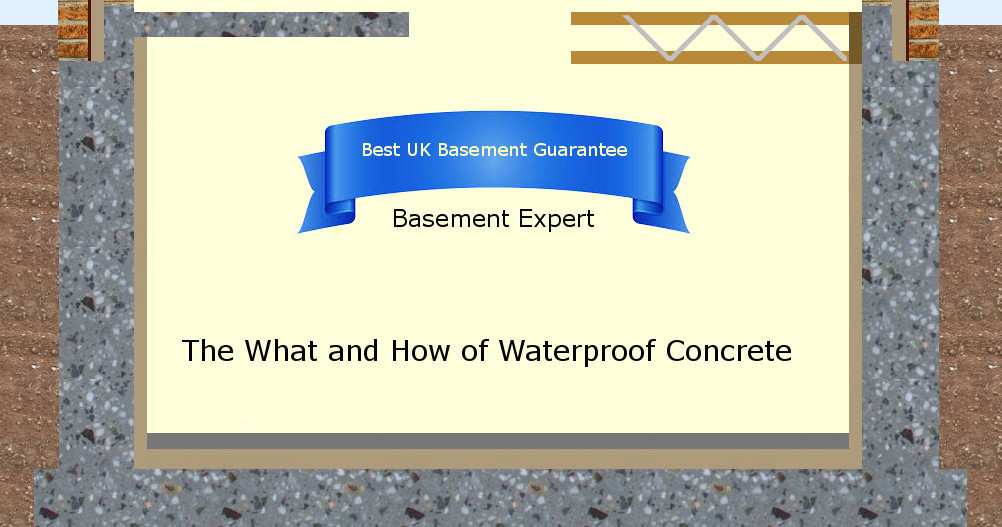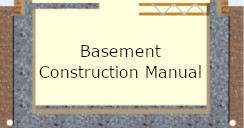| |
Waterproof Concrete.
If you want information on ordering waterproof concrete, go here instead. This page is sharing all my knowledge.
This page got a major re-write starting July 2024. Away from the big readymix suppliers. Towards Mixamate, who mix on site only as much as you require with the same weigh-batch accuracy as the big-brand drum delivery trucks - as well as many other benefits.
I informed Mixamate of my content here. I have no commission or affiliate programme with them. My loyalty is only with my client. My opinions are my own.
The biggest of many benefits mixing concrete at site is working time. 2 hours instead of 2 hours less the journey time. Lots of readymix batching plants have shut now, meaning that journey times are often over an hour, leaving only a few minutes to try to get the finish you would like.
A waterproof concrete basement, properly designed, properly prepared, properly reinforced, properly poured, properly compacted and properly cured under proper supervision is the best material with which to build a new basement.
It will be fully waterproof with waterproof joints and nothing, whether the digger backfilling, scaffolders carrying poles, bricklayers and their heavy boots, craning materials around site, will damage it.
You may be sick of reading about it on this web site, but in 2022 BS8102 changed. A complete U turn. Internal drainage is out. Building your structure to be waterproof is in.
Building your basement, properly and with care, with waterproof concrete is the simplest and cheapest solution most likely to succeed.
But the design team, main contractors and sub contractors must all change their ways, because their ways have been failing clients for too long.
And, sadly, big readymix companies have been letting me down as well.
I am naming Hanson and Cemex in particular. I am choosing to blame their dumbing down of the batchers who actually make their concrete and load their trucks.
The goodies, that I know of in my area, are Coppard in Sussex, Gallagher in Kent and Mixamate who cover London, Surrey and a bit more.
1. Waterproof Concrete.
Waterproof concrete is a specific mix of completely normal aggregates, cement and water.
Waterproof concrete has extra sand to completely fill all the spaces between the stones.
Waterproof concrete has extra cement to completely fill all the spaces between the sand.
Waterproof concrete has a lot less water so that grains of cement are not pushed apart. Grains of cement probably touch neighbours in the fresh, wet waterproof concrete mix.
Normally concrete has more water that pushes grains of cement apart reducing the friction and adding workability, which is why extra water is very popular with labourers. More water significantly reduces the amount of work they need to do.
But more water weakens the concrete, increases drying shrinkage cracking and makes concrete more porous. The problems caused by more water in concrete are unpopular with clients.
As the surface of each grain of cement blends with the surface of the water against it, gel is formed with a slight expansion. The gel turns into long, thin, crystals.
The closer the grains of cement are to each other in the fresh, wet concrete, the more crystals from one grain get tangled (interlock) with crystals from neighbouring grains.
It is this continuous skeleton, of crystals from every grain of cement interlocking throughout the concrete with crystals from every neighbour, that gives concrete strength.
The less water, the thicker the continuous skeleton and the stronger and more water resistant the concrete.
Therefore, the essential difference between waterproof concrete and the rest is:
a complete sheet of interlocked crystals, continuous around and between every grain of cement throughout the entire batch of concrete, made soon after the concrete begins to set.
As more cement reacts with more water, this continuous sheet of interlocked crystals thickens to a mat.
Rather than, with more water:
Grains of cement surrounded by interlocked crystals that, for a long time depending on how much water pushed cement grains apart, have no connection with crystals surrounding neighbouring grains.
Until crystals interlock throughout the batch of concrete, no concrete has been produced.
Depending on how much extra water there is, the eventual continuous mat of crystals will be thinner. And any remaining water will be continuous throughout the concrete, allowing water through under any pressure.
The mat in waterproof concrete gets thicker and thicker until remnants of grains of cement are left trapped one side of the mat and remnants of water are left, sealed in tiny pockets, the other side of the mat.
When no more water can reach remaining cement grain all reaction stops. The concrete is waterproof.
That is ....
until ....
there is a crack.
Concrete warms up and expands when it cures and cools down and shrinks as it cools, usually a day or two later.
It is inevitable that concrete will crack upon cooling in parts of a concrete structure that are restrained at the ends. In my experience, a 20m long basement retaining wall of waterproof concrete will shrink about 4mm.
The 'trick' is to have sufficient horizontal steel reinforcing bars that grip the concrete either side of a crack instantly and prevent that crack opening more than 0.2mm.
This will make the concrete crack again and again until all the cracks add up to the total thermal shrinkage which, in my example, is 4mm over 20m, which requires 20 cracks if each is 0.2mm wide.
When waterproof concrete cracks it is the continuous mat of interlocked crystals that cracks. Unused water will find remnant of cement grain and the curing process begins again. A crack up to 0.2mm wide will completely heal. This is called autogenous healing.
Some other concrete elements, such as basement floor slabs, are not restrained and can expand then shrink as a whole without cracking.
Non-waterproof concrete will always be weaker and more porous than waterproof concrete because the waterproof concrete is a better blend of solids and less water pushing the solids apart. Increasing the water increases the amount of cement that is turned into crystals but extra water reduces the amount of crystals surrounding one grain of cement that interlock with crystals surrounding each neighbour.
|
|
2. What big readymix producers get wrong. Specifically, what Hanson did, and what Cemex are doing, and what emerged from Breedon.
First, let me explain Ordinary Portland Cement. It will contain about 5% gypsum added to the finely ground clinker.
The gypsum reacts with the mix water seconds after the water is added at the mixer. It was found, decades ago, that the gypsum reacting first stops the cement clinker reacting for about 2 hours. This gives time for the fresh concrete to be transported, discharged, placed, compacted, and finished, before it begins to set.
But, with waterproof concrete, we have opposing water requirements.
-
On the one hand, the gypsum needs enough water to react in the way we need it to. Insufficient water and it doesn't react and the cement clinker reacts early. The concrete is already setting before the truck arrives.
-
On the other hand, the amount of water in waterproof concrete needs to be restricted. Ideally to 45% to 47% the weight of all the cement binder (which might contain gypsum, lime, GGBS, flyash, microsilica, or other substitutes). 45% seems to be enough to get the gypsum reacting and in tests to BS EN 12390 part 8 the concrete is proven waterproof.
Most concrete for other purposes has more than 45% water. Probably more than 55%. It has plenty of working time and is strong enough for its purpose.
With Hanson many years ago, with Breedon last year and during an awful day with Cemex earlier this year (2024).
The first load arrived too dry. Hot. Setting.
By adding loads of my powerful plasticiser powder - at very great expense - the concrete goes through the pump and by spreading it and compacting it in the bottom of the floor it can be covered over with better stuff later in the day.
If
If the batcher listened and understood.
Coppard and Gallagher have English-speaking batchers who can discuss my requirements with their manager and get changes made quickly.
Breedon, last year, were very hard work. But they did make the changes.
Cemex, this year, refused to make the changes. Refused to accept they did anything wrong. In the end we had to send a load away. They charged for the load and they charged to take it away.
The Breedon conversation.
I ordered 60mm slump at site which puts the concrete in the range of S2 consistency.
When the concrete continued to arrive too dry, the batcher told me over the phone that he puts 800 litres of water into a load of S2. And 1000 litres of water into a load of S3.
But, as you read just above, it is the ratio of water to the weight of cement binders that needs to be understood. If a batch has 220kgs of cement binder per cubic metre, plus some water in the sand and some water in the truck from when it last washed out ...
800 plus 130 (in the sand, a guess, it varies) plus 30 litres of water = 960 litres. Divide by 8 cubic metres = 120 litres per cubic metre. 55% water to cement ratio. Perfect for most purposes (though beware of labourers adding more water at site).
But 120 litres as a ratio of 350kgs of cement binder required for the concrete to be water proof is only 34%. Much, much less than the water required for the gypsum to do its job.
I pleaded with the Breedon batcher and we got it right before too long.
The Cemex conversation.
The batcher was a foreigner who seemed as unwilling to hear as he was unwilling to understand.
Cemex management is divided into clear disciplines, such as sales, shipping, technical. They don't seem to talk to one another. They send messages, which are easily ignored. (Or, at least, not read immediately).
When the driver of the first load arrived with the third load, after I had been trying my hardest to make the batcher add more water, he said he told the batcher the same but he refused.
During the debrief with Cemex
My phone calls at the time, sometimes on the client's phone, explained that the concrete wouldn't discharge. It was that dry. Dryer, I would say, than the 34% Breedon seemed to have supplied. The batcher was saying much the same as the Breedon batcher. He knew how to make S2.
In subsequent emails
"
Following the internal investigation carried out regarding Mondays rejected 3rd load please find the attached invoice for return load charges for the rejected material.
As per BS EN 12350-2 the maximum allowable deviation based on a spot sample taken from the initial discharge of a ready-mixed concrete truck for target slump (mm) 50-90 is ± 40mm. Therefore, as the material was ordered on a 60mm slump the tolerance for this sits between 20-100mm.
Due to the material being rejected without being slump tested on site we have no evidence to prove that the material was not with in the required specification, therefore it is the view of the business that the supplied material was within spec and return load charges will stand.
Following a conversation at 0919 between Lewis Archer in CEMEX Internal Sales and Philip Sacre on site, load 3 was put on hold pending the successful offloading of the second load. At 1022 load 3 is released by Kevin Egan in CEMEX London Shipping following a call with (client) on site as (client) is chasing for the 3rd load to be sent. No changes to the material are requested at this point.
As no changes were requested to the material ordered following the offloading of the second truck it is again the view of the business that the material received on site was within the requested specification and return load charges will stand.
"
"
We also note that water was added to the delivered loads. As per our terms of sale, this then puts any liability for the concrete with the customer.
"
"
But, Lewis told me over the phone, after the third load had arrived, I think, that the technical report he had, stated that the P350 over-sanded mix with no additives of your own and a target slump of 60mm at site was made with 193 litres of water per cubic metre. I presume he meant free water. That would be a WCR of 55%. Plenty of water to get an S2 or even S3. I think that somewhere the system recognised that with only CEM 1 (pure OPC) going into the concrete, that 193 litres was the minimum to avoid ASR.
"
BUT THE CEMEX BATCHER OVER-RODE THE SYSTEM. EASILY.
From the Cemex website.
All CEMEX batching plants are fully automated and controlled by the GINCO system. The system automatically controls the exact batching requirements of each mix design to ensure consistency and accuracy of constituent parts.
BUT THE CEMEX BATCHER OVER-RODE THE SYSTEM. EASILY.
THE COMPANY USES ITS GINCO SYSTEM IN DEFENCE. WHILE THE BATCHER DOES WHAT HE LIKES.
Another issue with readymix.
Journey time.
The journey from the Cemex plant at Datchett to the site near Woking is 23 minutes on Sunday by car (Google maps). But one of the delivery tickets says batched at 7.37 and arrived 8.44.
If there had been 2 hours working time, after my powder is mixed in there is only 45 minutes left. To discharge, pump, level, compact, level again and smooth 8m³.
|
3. Gallagher and Coppard
I have found both firms very reliable and able to tweak later deliveries when I ask them to.
|
4. Mixamate.
Mixamate make their own trucks near Sheffield. They have adapted and improved them over many, many years. They make different trucks with different specialities.
Like readymix, they weigh each ingredient. The computer won't let the driver continue unless an ingredient is added at the correct weight - including the correct water. However, I know that the driver can add more water after the mix is complete, if you request it, and the system records it.
Amongst the fleet, are trucks that weigh batch concrete and pump it through a 3" diameter flexible hose. The truck carries 65m of flexible hose. The extra charge for this truck that pumps is £400 plus VAT.
The man is there for you to talk to, not pretending he cannot hear you on the end of a phone or just sending a message to another department so nothing happens.
|
|
Mixamate coverage in the south east.

|
On this, the first occasion I used Mixamate, the aggregates were dry due to the weather. After the first mix was complete, I was invited to add more water as I wished. There needs to be just enough for my powerful plasticiser to make the big difference it makes. We noted the extra water and set the water-adjust to do the same from then on.
Mixamate buys aggregate premixed. Ballast and concreting sand (which is like sharp sand but more evenly graded). It gets delivered to its yards in Edmonton, West Drayton and Woking (at least) in the London area. Throughout the day, all their trucks are visiting the most convenient yard, to top up, depending on where they go next.

|
|
This is the detailed control panel. Mix design 33 selected.

|

As the batch is made, you can see everything going on on the screen. Any extra water added is recorded.


Whereas all standard boom pumps and line pumps wash their hoppers out to the ground. Sometimes you just leave it.

Sometimes it is in the public road. You mustn't block the drains. You mustn't leave any for your neighbours to drive through and splash concrete on their car. It is an extra hour of work.

The standard 4" line pump weighs about 100kgs for the last 3m full of concrete. It is hard to bend to your will and heavy to drag around.

|
|
Whereas the 3" Mixamate line is much lighter and more flexible.

|
Using Mixamate, you have the quality and 2 hours working time instead of 45 minutes, making it massively easier for you to get the finish you would like.
This still is from a video the client took the following morning.
|
|

|

|
|
Whereas this image, of work a few months earlier, shows the Cemex concrete described above, from Datchet plant, being covered over the following day with what should be the same concrete from Cemex, but is from London Concrete's Colnbrook plant.
Obviously much better.
But water content is only half the story.
Google maps says that on a Sunday morning both journeys would take about the same. 23 minutes or so.
But, on the day, the Cemex journey was over an hour, whereas the following day the London Concrete journey was about 30 minutes. Delays, holdups, road works, accidents, incidents and school times are out of your control. But the quality of your finished concrete suffers from any of them on the day.
|
This is London Concrete concrete as well. At Rickmansworth, batched at Watford.
It was not a very good team of labour. They said they would go back and fill this depression. But the concrete had set and they couldn't.
For months, they walked through 60mm of water, getting wet feet.
I cannot stress enough how valuable the extra time is for you and your project.
|
|

|
Mixamate have quite a number of the trucks with their own pump. When the first is empty, the next can arrive and carry on.
Mixamate employ a technician and they have a test lab. Quality control is a priority for them.
Video of the Mixamate pump truck.
5. Why I say you must never use a volumetric truck for high quality concrete.
Do you need High Quality Concrete?
You need high quality concrete if
-
You want your concrete to be resistant to water.
-
Your concrete is specified with a minimum strength requirement.
-
Your concrete needs to be designed to a Class of Chemical Resistance. E.g. DC2
You need resistance from
- oxygen
-
chloride ions
-
carbon dioxide
-
any other potentially deleterious substances identified in your soil report
-
Your concrete needs to be designed to a specified Exposure Class. E.g. XC4
This image is from Ebay.
The tell-tale sign that the volumetric is the type I am talking about here, is the tube with a screw that lowers down at the back.
|
|

|
I need to say at the outset, volumetric truck manufacturers offer extra features to those who will pay for them.
But customers shop around on price. The concrete suppliers who advertise mostly buy a cheaper truck without extras, and if one of their competitors found a way to cheat and appear to be cheaper on the phone, the others will have to use all the same tricks to compete.
-
They carry only ballast. Ballast is as-dug out of the ground with clay and silt removed. It is not dense. It is full of voids. Unless your concrete has a lot of extra cement powder to fill all the voids, which costs you a lot more, your concrete will be weak and porous.
-
They have a meter which tells them how much concrete you used. But if they reduce the figure they tell you equates to one cubic metre by 20%, you pay 25% more for the true amount of concrete you used. Because every time you use 4 cubic meters they tell you that you used 5.
-
They may not have enough of something and don't go back for more before they come to you. Because to lose an hour and spend more on diesel to top up the water, cement or ballast means they can sell less concrete that day. They sometimes make you poorer concrete than you ordered.
-
The driver is controlling the speed of the conveyor, which alters the cement to aggregate ratio. Not the computer. He can reduce the cement and reduce his cost.
-
The amount of water in the concrete isn't consistent until the driver gets the hang of what you seem to want. He turns the tap. More water increases the volume and increases his profit.
I used a volumetric for concrete blinding (2022). It was the site manager's mate. He chose them. The driver was smart and clean, which is unusual, and he refused to put more water in for me because he wasn't carrying enough. So I had to injure myself struggling to spread stiff concrete. Of course, the site manager said he had a bad back and he refused to help.
|
6. Pumps.
I have a short page just about pumps here. It has a photo suggestion of how to fill wall formwork fairly easily with a Mixamate pump.
7. Proving that you have Waterproof Concrete.
BS 8102 deals with the waterproofing of beneath ground structures.
From 9.1 of BS 8102:2022 on page 36.
"Concrete structures containing a water resisting admixture should be deemed to have a lower degree
of water / vapour transmission when the design of the concrete mix and casting of the structure is
adequately supervised and the admixture is assessed and certified (see 9.2.1.3)."
I deal with 9.2.1.3 in the text box 'What academia says about Waterproof Concrete'.
"Where the waterproofing admixture has been assessed and certified by a UKAS-accredited body or
a European Technical Approval body, certification information should be referred to for guidance on
use and the extent or limitation of technical benefit."
On page 53 of the new BS 8102:2022, BS EN 12390 part 8 is quoted.
|
|
Click on this image to open an original test certificate.
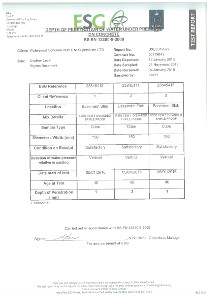
|
This is the start page on the British Standards web site for BS EN 12390, Testing Of Hardened Concrete.
Part 3 is used thousands of times every week: Compressive strength of test specimens
Part 8 is Depth of penetration of water under pressure.
|
Here is a photographed extract from my copy of "Advanced Concrete Technology", the volume called "Processes", the Chapter called "Concrete construction for liquid-retaining structures" by Tony Threlfall, 2003, Butterworth-Heinemann. Page 16.2.
|
|
Click on this image to be able to read the text from the whole page.
|
|
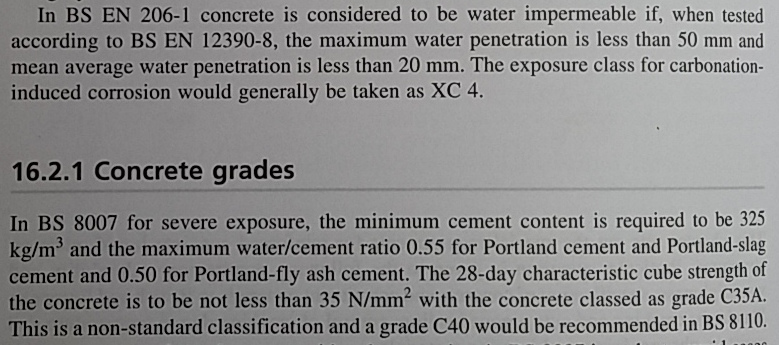
|
The pass mark for BS EN 12390 part 8, depth of penetration of water into hardened concrete, is 20mm.
If your architect, structural engineer, building control officer, warranty provider or lender insist on you using a product with a BBA certificate. Fight back. They will think they are still correct trying to meet the 2009 version of BS 8102. They are not meeting BS8102:2022. Go here to the
BS8102 page where I reveal the truth behind BBA certificates. This is the same as the link above.
Nowhere does BS 8102:2022 mention BBA or BBA certificates.
Another certificate. ESG became Socotec between 2016 and 2018, but they are from the same lab.
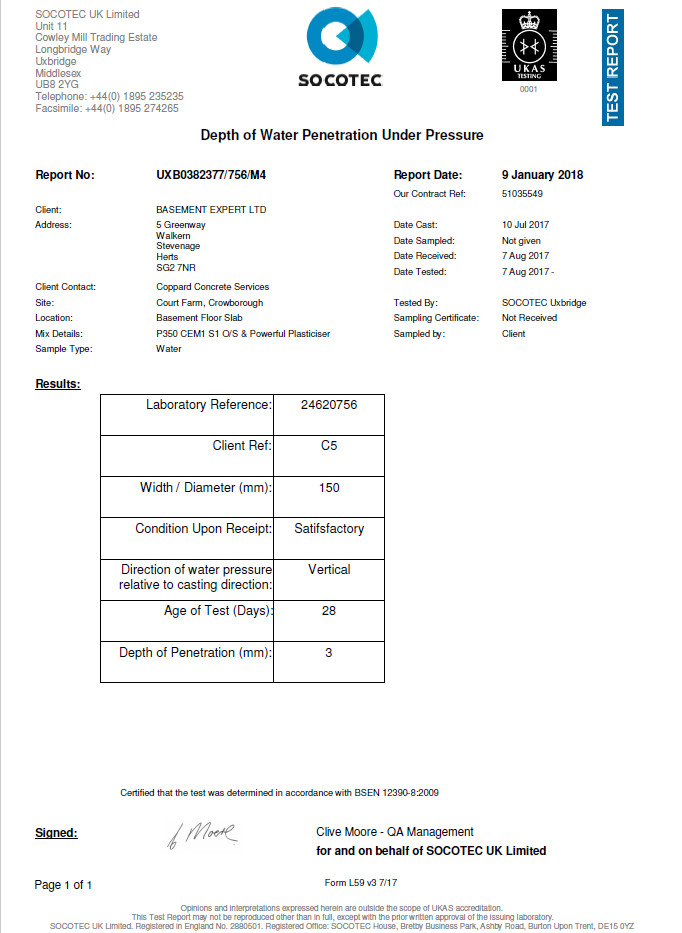
|
|
8. What Academia says about Waterproof Concrete.
First, I promised elsewhere to return to 9.2.1.3 in BS8102:2022.
"
9.2.1.3 Concrete containing water resisting admixtures
COMMENTARY ON 9.2.1.3
There is a range of products, generally categorized as water resisting admixtures, which seek various ways to increase the inherent resistance of concrete to water and water vapour. As the mechanisms used each product to achieve these aims are quite diverse, it is not possible in this British Standard to give specific guidance on their use.
"
|
From the summary on page 55 of the report cited below: "Section 2 lists the types of materials that may be categorised as water-resisting admixtures and describes some of the mechanisms by which they may resist water penetration. However, the working party was unable to obtain details of the constituents in most of the commercially available water-resisting admixtures."
and:
It seems that with regard to water-resisting admixtures the available information has not been expanded
on from what was available nearly 20 years ago when Neville (see Section 4) commented:
"Unfortunately, little information is available to make it possible to explain and classify the actions
involved so that reliance has to be based on the manufacturers' data coupled with experimental
evidence on the performance of any particular waterproofing admixture".
A working group of 18 academics, major contractors, engineers and consultants decided to investigate whether and how corrosion of steel reinforcement might be prevented when the reinforced concrete was formed against sea water in the Arabian Peninsular. They sought to avoid stainless steel reinforcement by finding out how concrete might be improved to reduce corrosion.
They published:
The influence of integral water-resisting admixtures on the durability of concrete. Concrete Society. 2013.
For all the years since 2013, I have had my eyes open looking for clues. Cement and anything else that might be harmful has to be declared on safety documents. Cement and cement substitutes, such as calcium carbonate, are present in several brands including, I believe, in Pudlo, Sika, Xypex, Kryton and Triton.
In addition, all the brands require their admixture to be added to a very dense mix of concrete with limited water content.
It is my assertion and firmly held belief that water resisting admixture suppliers all want their admixture added to already very water resistant concrete.
The same report quotes the Pudlo BBA certificate, which is fairly typical of many BBA certificates for so-called water-resisting admixtures.
Pudlo BBA Certificate 01/3842
"Concrete containing the product will have enhanced resistance to reinforcement corrosion when
compared to the equivalent plain concrete". "Under normal conditions of service, concrete
containing the product is more durable than an equivalent plain concrete".
If more cementitious powder is added to an already very dense mix of concrete, it will make that concrete a little bit more dense and reduce the water cement ratio very slightly and the claims made on the Pudlo BBA certificate are exactly what you would expect.
Obviously, it would be easier and cheaper to ask the readymix producer to increase the cement content by the same amount.
At an exhibition, Kryton told me their paper sack contained sand as well as cement because the sand was necessary to break the paper sack open quickly.
In section 4, the report reviews the available information. They found that all the BBA certificates for water-resisting admixtures were based upon tests with very different control concretes, making the different brands impossible to compare side by side.

|
|
Pudlo immediately seems to be much better.
But, actually, if Pudlo had been added to the other control concretes it would have had similar results to those other brands.
Caltite is not here because the Caltite BBA certificate had less information. The report says the Caltite control concrete was not even as good as typical structural concrete. An academic paper cited in the report stated that Caltite only reduced transportation of water in much wetter concrete. It did nothing in low water concrete. This will be because Caltite contains no additional cement product. It contains a polymer emulsion that only works if it is thoroughly dried, which, obviously, has to be after the concrete has cured or else drying the concrete too early would affect its strength because the necessary chemical reactions would stop too soon.
|
Page 16.
"
When the original tests were conducted, the aim was to demonstrate the increase in performance over respective control concretes and so the various materials cannot be directly compared. This is demonstrated by the range in 28-day compressive strengths for the concretes containing water-resisting admixtures (59-82 MPa) and their control concretes (47-63MPa). In addition, many of the water resisting admixtures achieve a reduction in water/cement ratio and caution must be exercised when assessing performance (see Section 5.3) to differentiate between the effect of the change in water/cement (which could be achieved with a water-reducing admixture) and any additional effects.
"
Nevertheless, the same report states on page 36 "water/cement ratio .... primary measure of water penetration and hence the durability of the concrete."
1988: "Theoretically, cement pastes with a water / cement ratio of <=0.5 achieve capillary discontinuity"
Lea, F. and Hewlett, P. (1988). Lea's chemistry of cement and concrete. 4th ed, p888. Oxford: Butterworth Heinemann.
But in 1988 no one had discovered how to add sufficient workability to such a dry mix. Super plasticisers could not be used in sufficient quantity without getting unwelcome effects, such as flash setting or weeks of retardation.
In 2011, the new edition of a long-respected university text stated more clearly than ever before that completely waterproof concrete could be produced without admixtures.
"concrete with a low water/cement ratio ... make the capillaries discontinuous" Neville, A.M. (2011). Properties of Concrete. 5th ed, p330. Harlow: Pearson Education.
|
For years I have always used the concrete mix that is proven to always be completely impermeable. Without any proprietary admixture not proven to do anything but cost a lot of money. I just add my own very powerful water reducing plasticiser.
9. Waterproof Concrete Admixture Suppliers.
I found the guarantees given by some of these brands.
None of them seem to guarantee anything beyond what should be expected of structural concrete without any water-resisting admixture.
There are two examples of the Caltite guarantee on this web page. Where Caltite might have misled you is confusing the fact that Everdure Caltite, that contains a polymer, will waterproof non-waterproof concrete if the concrete is first kept moist inside and fully cured (which might take a month) then oven-baked long enough to dry the concrete and the polymer completely. They may have shown you an example where concrete above ground in Australia did exactly this. But beneath ground in Britain the polymer could not and will not work. Indeed, academic evidence is that if the polymer does not dry out it actually increases the transportation of water through concrete. The opposite effect.
You need to go to page 26 to find the exclusions in this Sika guarantee. Over the years I have had a few phone calls from people whose lives have been severely blighted by new basement construction suffering seemingly incurable waterproofing problems. All the worst sagas involved Sika. I was once called by someone calling himself a Sika sales manager who claimed this claim of mine was untrue. I was able to give him the phone number of one of these unhappy people. I didn't hear from him again.
If you go to the Kryton web site It all sounds very good until you realise that, like Sika, they are selling some extra cementitious powder and they promise only what extra cement will achieve. 0.25% extra cement does very little. But to say more water resistant, stronger, more durable would all be true even if only 0.25% true.
Pudlo and Xypex are selling extra cementitious powder as well. Let us not forget that the David Ball Group, that includes Pudlo, have a leak repair division as well.
Actually, the clever ingredient in every one of these admixtures is not a waterproofer but a powerful plasticiser. I am using the sixth I have found, each time having found better, and people who know tell me mine is best. Obviously, it is also the most expensive I found as well.
All powerful plasticisers are based on PCE, polycarboxylate ether, which is a very long molecule that clever chemicals can be fixed to.
Producers invent their own combinations of clever chemicals and patent them.
PCE with clever chemicals are used in concrete admixtures for a variety of uses, such as plasticiser, retarder and so on, and also in inks, paints and cosmetics.
Powerful plasticiser is a combination of PCE, electrostatic repulsion and glue.
The electrostatic repulsion isn't greatly different to naphthalene super plasticisers invented over 50 years ago. But with naphthalene it was liquid repelling liquid and its effect was limited.
PCE powerful plasticisers stick to the cement grains so that the solid cement grains are repulsed from each other and friction is reduced many times more than it was with the older technologies.
PCEs vary enormously. To have sourced a PCE is a long, long way from having sourced a very powerful plasticiser.
Beware of liquid PCEs. The 'glue' soon falls off after the stock arrives in the UK from the Far East. They effectively revert to a 50 year old super plasticiser technology in terms of effectiveness.
Never allow a liquid PCE plasticiser, which must include Caltite.
Every one of these product BBA certificates or the product literature or the safety document confirms that all allegedly waterproofing admixtures for concrete contain a water reducing plasticiser. I believe the rest of what they say to be smoke and mirrors.
Since 2013 I have travelled to the USA and Asia many times looking for better and better plasticiser. The one I have now is very powerful indeed.
Waterproof concrete is so dense nothing can get through. But this very dense mix would be too dry to pump and properly compact. It (only) needs very powerful plasticiser.
I put my powerful plasticiser into the concrete at site.
It is the only way I can be sure that the batching plant limited the water content.
The concrete arrives with stones rattling loose in the drum and the concrete breaks apart as it is turned slowly.
My powder is added and I count 6 revolutions per cubic metre. It is quite clear, listening to the concrete, that my powder works because it becomes more workable, the stones stop rattling and the truck becomes stable and peaceful. Whereas it lurched at the start each time a huge volume of dry concrete crashed as the drum turned.
I feel that adding my admixture at site is the only way I can be certain the concrete has less water and that my plasticiser is definitely working.
None of the brands do this, as far as I am aware.
In particular, how could a liquid brand like Caltite know whether the tiny amount of essential powerful plasticiser within the 30 litres of mostly bituminous emulsion still works? Hasn't fallen to pieces?
Pudlo used a control concrete without admixture a lot more water resistant than the concrete other brands achieved even with their admixture.
Proving that waterproof concrete is at least as good as the Pudlo concrete with Pudlo in it. Or, perhaps waterproof concrete is a lot better. Perhaps it is zero and off the bottom of the chart by miles.
The proper test for waterproof concrete is BS EN 12390 part 8. But no BBA testing involved this proper test.
Pudlo's improvement wasn't greatly different to the improvement others obtained. If Pudlo was added to any of the others' control concretes, it would not be significantly different.
I think Pudlo continued to cheat long after they got a BBA certificate.
Pudlo have had presentation to specifiers slides available on the internet. This image is from that presentation.
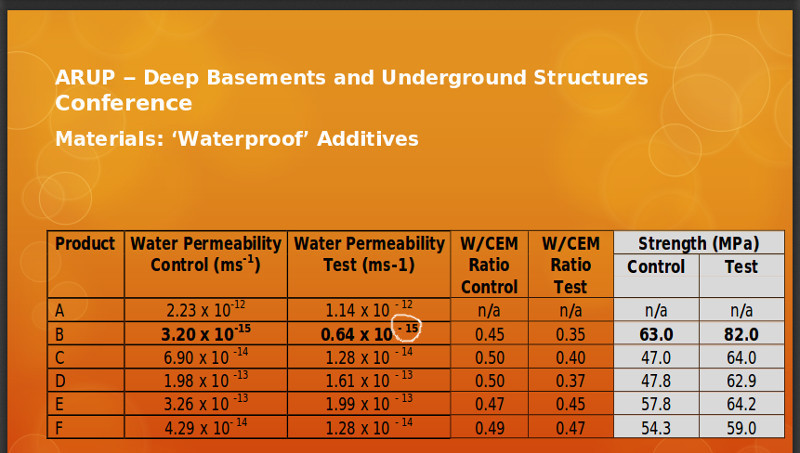
They highlight in bold, I added the white circle, a figure a thousand times better than the figure above, which is Caltite. These are the same figures from BBA certificates plotted on the chart above.
This table would allow you to believe that Pudlo is 1,000 times more effective than the product above. Whereas the chart shows you it made a similar tiny improvement comparable with the others.
If you look at the water cement ratio figures to the right of my white circle, the ratio in the control is 0.45, while the ratio in the test was 0.35.
10% less water by weight of cement could not be explained just by adding more cement to the control concrete, because 45% of 350kgs is 157.5 kgs or 157.5 litres of water per cubic metre of concrete.
To reduce the WCR by 10% to 0.35 would require another 100kgs of cement per cubic metre of concrete. Exactly 450kgs.
I have seen Pudlo at a batching plant. The paper bag could easily be held in a hand.
It weighed nothing like 100kgs. Probably about 8kgs.
Significantly reducing the water this much surely means three things.
-
They doctored the control concrete before they added their product by reducing the water in it. Cheating.
-
The concrete was made with insufficient water to make the 5% gypsum in OPC react first, meaning the concrete had a flash set instead of 2 hours working time. If this concrete was delivered to site it would barely come out of the drum. It would not go through a pump. It would take many more men the same time to spread it, compact it and finish it.
-
The grains of cement are not pushed apart at all. Pudlo seem to have managed to compact their test sample and, properly compacted, it would be a very strong and waterproof mix. Which is why they reduced the water in the way they did.
The massive increase in strength is only slightly because of their product. It is mainly because they reduced the water content.
If you think Pudlo is better because you saw this slide, you might now think you were duped.
Some time after I wrote this page, the David Ball Group that includes Pudlo went into administration.
This link opens a press article.
We will have to wait and see whether it reappears, and whether any guarantees will be worth anything.
Incidentally, the slide above shows more clearly than my chart which data Caltite omitted. I think the Caltite admixture made the concrete weaker.
|
|
This link opens the Material Safety Data Sheet for my powerful plasticiser powder.
|
|
